Learn to Trade, It Is Never Too Late
By our statistics, standard indicators show an average probability to conclude the indicated price direction with a 55% probability or below. High probability trading systems use a different systematic and strive for a likelihood above 65%; helping you to be more often on the right- than on the wrong side of a trade.
Watch our Feature Presentation of why you want to work with a high probability trading system and read the details below.
In general, we differentiate three types of investors or traders:
Long-Term Investor: Focusing on buy and hold, making money when asset prices rise; working mostly with fundamental analysis; on the search for assets with a higher performance expectation. Positions are held for weeks, months, and years.
Swing Trader: Trading with short-term money moves of selected assets, based on technical- or fundamental analysis. Asset positions are held for multiple days or weeks.
Day Trader: Positions are opened and closed at the same day. Rarely is a position carried overnight; in particular on stocks, preventing gap risks, while futures trade more or less 24-hours a day.
Are traders or investors better on in the long-run?
To answer this question, we measure the return expectations for stock trades/investments.
Our models are based on institutional money flow. Table-1 shows institutional market drivers and followers per key market segment.
Table1: Institutional Investors
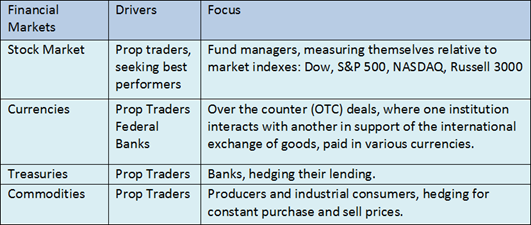
When institutional money starts flowing in or out of an asset, the average expected price move of the share value in the next 1-5 days is about 1.8%. Taking a long-term perspective from a weekly chart, a 3.5% price move in the next 1-5 weeks can be expected. Those, who open and close positions at the same day, achieve about a 0.6% price move with the average stock. Calculating the median-time for staying in a trade, we came to three bars, this means:
Long-term Investing: 3.5%-return on capital engaged in three weeks.
Swing Trading: 1.8%-return in three days.
Day Trading: 0.6%-return in about 3 hours.
For our calculations, we assume a high probability trading system, giving you two wins out of three trades:
Graph-1: AAPL Daily NeverLossTrading HF Chart
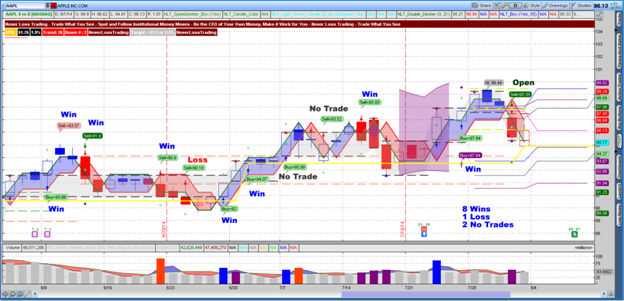
In addition, let us assume a 1:1 reward/risk setup for each trade.
Based on those assumptions, we compare the return expectation of the three different traders/investors; calculating the upper part of table-2 cash based, applying a 2:1 margin for swing traders and long-term investors and a 4:1 margin for day traders:
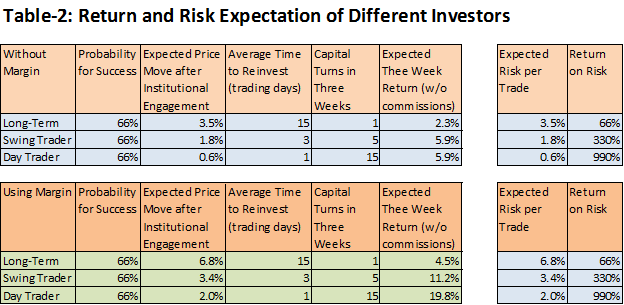
The two calculations show that the day trader, when using margin, can expect the highest return and is risking the least amount of money per trade, while the long-term investor is taking a risk above the average expected return. Swing Traders in both examples have a positive expectation between risk and reward.
Why do so many people prefer long-term investing?
Our answer: This is what you been thought investing in; thus you prefer long-term holding of Mutual funds, 401(k), and broker held assets or ETF’s. When you hold assets for the long-term, you allow for the institution of your brokerage account to sell call options against your assets, giving them an average return of about 1% per month that you never see in your account.
If you want to make a change to this, there is only one way, learn to trade, it is never too late:
Regardless if you are a fulltime or part time trader, make trading your own business and take it serious. Unfortunately, many new traders feel they can make a lot of money in the financial markets with little knowledge and little engagement. However, the best way to trading success is to replicate the setup of a professional trader, working at an institution, where they have their support- and control network, assisting them to strive for success.
One way or the other, build a base to replicate such network, either on your own or by engaging in a premier trading education institution. Here are the key components for your trading success:
Component-1: Trading System
Without a reliable system, which constantly gives you clearly defined entries, exits, stops, and odds evaluations, trading success is rather random and mostly inexistent.
In general, we find three types of trading systems and compare them based on measured probabilities for success, resulting in an average expected return rate.
Moving Average Based Systems take their trade entry comparing longer- and shorter-term price happenings from the past and initiate an entry when the longer- and shorter-term component of the observation are crossing.
Prediction Based Systems assume that longer-term price patterns repeat themselves and thus allow the trader/investor to follow them.
Activity Based Trading Systems analyze short-term changes in supply and demand patterns, indicating the setup of a potential directional price move.
In the first example, the systems are compared on cash investments into stocks. The dynamic and impact of using leveraged instruments like options or Futures, brings referring higher outcomes. All results published are based on years of statistical materials and 30 years of trading with many different models.
The following example shows that the average trader can expect a 300-percent favorable outcome, when using a high probability and activity based trading system.
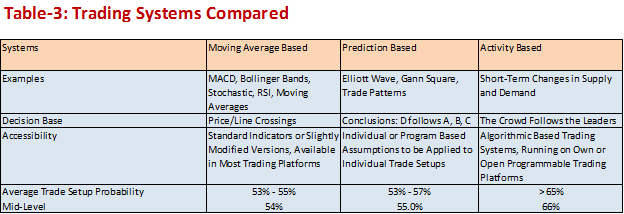
Aside from the return expectation, the average costs of a trading system are a key consideration. Let us compare those and the payback cycle for a stock trader using $50k with margin or $100k in cash. We further add a Futures Trader, using $10,000 in cash, applying one-quarter of day margin.
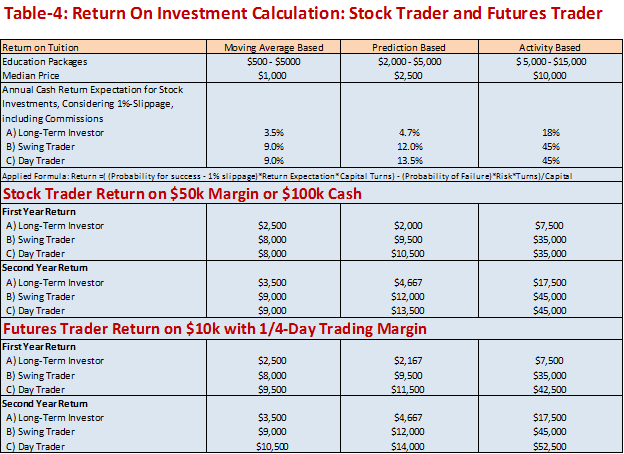
The first year calculation includes the recuperation of the initial tuition costs.
For both traders, you see that activity based trading systems; even so they ask for a higher initial investment, produce returns far beyond moving average- or prediction based systems.
Every trader brings a different risk tolerance and affinity to assets and trade environments. Hence, one system does not fit all; hence, the best for you is to find a system with individual education tailor made to your wants and needs, helping you to turn yourself into the trader, you want to be.
Component-2: Stay Engaged
To realize the constant returns we based our calculation on; you need to stay engaged in the markets, having a way to constantly find trading opportunities for the next trade to come. Key questions are:
Question-1: From the about 40, 000 stocks traded in the US, which ones show an institutional initiated price move?
Quesiton-2: Do all stocks provide favorable trade conditions, given their volume, share of institutional holding, bid/ask spread, holding options or not, their P/E ratio or P/C ratio?
Question-3: Which Futures or Forex contracts indicate the desired trade setup and how to trade them best?
New traders at times limit themselves to just trading a couple of assets, but what to do if they do not show a price move, you might miss participating in a chance that might arise in gold or crude oil. In case you do not want to trade futures, but still you want to participate in the price move of a commodity, which instrument to trade: ETF’s or their Options?
Many questions that you have to answer on your own or you decide to rely on a subscription service or trading-system-inherent-market-scanners, which help you to find those opportunities.
There are various subscription services available for:
Day Traders: Stocks, Options, ETF's, Futures, Forex
Stock Traders: Stocks for Short-Term Trading, Swing Trading, Long-Term Investments
Long-Term Investors: Receive a 1-5 week perspective for, Stocks, Options, Futures, Forex
The choices is yours, but in any case, prepare to have a heat seeking finder, telling you which assets have strong individual price moves to pick them and to trade when they move.
The repots you can obtain vary from simple reports listing symbols to trade to very detailed reports that relate to:
- Defined entries, exits, stops, returns, options prices and more.
- Others just list the symbols of interest and you work out the details on your own.
The following table gives you an example of a more comprehensive report:
Comprehensive Stock Trader Alerts

In the continuation of the report an overall appraisal is given:

Finally, leading to define the desired price entry points and the related reward/risk appraisal, ending in proposing maximum prices to pay for NLT preferred options:

Imagine the time this will save you and the accuracy your trading will gain from a detailed trade setup alert like this or take any other comparable offer on the market, but stay engaged.
Component-3: Feedback
Who likes administration?
However, for you to turn yourself into the trader you want to be, you need to seek out for feedback. Again, you can try to replicate on your own how well you did on specific trades or you decide to take the advice from a coach, who is familiar with your trading system and can give you the final hints to get you over the hump.
Thus:
Document your trades, best with a screen shot from the trade setup you found on the screen and do the same when the trade is concluded, either in a win or loss.
With the help of this document, check you initial assumptions in respect to:
Entry: Did you pick a trade situation which was according to the rules of your system?
Exit: Did you stay in the trade until it concluded at the specifically set target?
Stop: Did you work with the stop level you decided that is needed for giving the asset price the wiggle room to develop in the desired direction without getting stopped?
Unfortunately, many new traders constantly violate Entry and Stop rules. Why is that? The fear of losing in a trade leads the new trader to take an early exit, either by taking profits early, or by trailing stops too tight. Both cases are very detrimental on the potential trading results, leading to a chain of: Small gain, small gain, bigger loss.
If you wanted to learn golf to make money, do you think working on your swing on your own would get you to where you wanted to be? Hence, find a coach, who gives you constant feedback on your trades, until you get them right on Entries, Exits, and Stops.
Component-4: Risk Management
In trading, we predict a probable outcome, but we control how much risk we take per trade.
Hence, you either have to work with an education institution or on your own to clearly define risk rules and act open them.
Agree with yourself a maximum number of losses or a maximum dollar loss that brings you back to the drawing board to re-iterate why things did not work in your favor.
In addition, your trading is better on when you find an agreement of how you adjust lot sizes in accordance to the odds ratio of each trade setup:
Odds Ratio: (Probability of success * Reward) / (Probability of Losing*Risk)
This factor should be above 1.5 for you to even start trading. In addition, you are much better on adjusting your lot-size by the referring odds ratio. Please check the example below which compares a stock and option trade at the same trade setup:
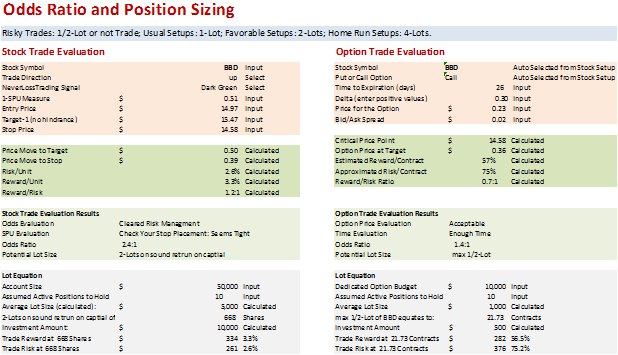
The example of the BBD-share shows that the stock trade has a more favorable trade setup than the option trade; thus, potentially investing into 2-lots on the stock trade and maximum 1/2-Lot in the option trade (if you even accept the option trade), results from the calculation scheme.
We hope, the effort we put into this article helps you as a trader to move along for your better.
Good trading,
Thomas Barmann
NeverLossTrading
A Division of Nobel Living, LLC
401 E. Las Olas Blvd. – Suite 1400
Fort Lauderdale, FL 33301
Disclaimer
This publication is designed to provide accurate and authoritative information in regard to the subject matter covered. It is sold with the understanding that the publisher is not engaged in rendering legal, financial advice, accounting, or other professional service. If legal advice or other expert assistance is required, the services of a competent professional person should be sought.
Following the rules of the SEC (Security Exchange Commission), we advise all readers that it should not be assumed that present or future performance of applying NeverLossTrading (a division of Nobel Living, LLC) would be profitable or equal the performance of our examples. The reader should recognize that the risk of trading securities, stocks, options, futures can be substantial. Customers must consider all relevant risk factors, including their own personal financial situation before trading. In our teaching of NeverLossTrading, in our books, newsletters, webinars and our involvement in the Investment Clubs, neither NOBEL Living, LLC, the parent company of NeverLossTrading, nor any of the speakers, staff or members act as stockbrokers, broker dealers, or registered investment advisers. We worked out trading concepts we use on a daily basis and share them through education with our readers, members and clients.
Find the Trading System of your Choice
Click here for an overview of the different NeverLossTrading Mentorships offered...click.




 US Stock Market Holiday Schedule:
US Stock Market Holiday Schedule: 